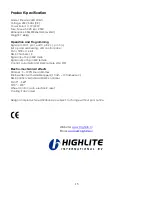
10
Control Panel
When the indicator light is on, means the LED Orbit I is working
Fig. 6
A.
Display
D.
Up Button
B.
LED
E.
Down Button
C.
[EXIT] Button
F.
[M/ENTER] Button
Control Mode
The fixtures are individually addressed
on a data-link and connected to the controller.
The fixtures respond to the DMX signal from the controller. (When you select the DMX address and save it, the
controller will display the saved DMX address the next time.)
DMX Addressing
The control panel on the front side of the base allows you to assign the DMX fixture address, which is the first
channel from which the LED Orbit will respond to the controller.
Please note when you use the controller, the unit has
10
channels.
When using multiple LED Orbits, make sure you set the DMX addresses right.
Therefore, the DMX address of the first LED Orbit should be
1(A001)
; the DMX address of the second LED Orbit
should be
1+10=11 (A011
); the DMX address of the third LED Orbit should be
11+10=21 (A021)
, etc.
Please, be sure that you don’t have any overlapping channels in order to control each LED Orbit correctly.
If two or more LED Orbits are addressed similarly, they will work similarly.
For address settings, please refer to the instructions under ”Addressing’ (menu
)
Controlling:
After having addressed all LED Orbit fixtures, you may now start operating these via your lighting controller.
Note:
After switching on, the LED Orbit will automatically detect whether DMX 512 data is received or not.
If
there is
no data received at the DMX-input, the “
LED
“ on the control panel will not flash.
The problem may be:
- The XLR cable from the controller is not connected with the input of the LED Orbit.
- The controller is switched off or defective, the cable or connector is detective, or the signal wires are
swapped in the input connector.
Note:
It’s necessary to insert a XLR termination plug (with 120 Ohm) in the last fixture in order to ensure proper
transmission on the DMX data link.




































